Camping is one of the most enjoyable ways to connect with nature, unwind from the daily grind, and create lasting memories with friends and family. But, one essential aspect that can make or break your camping experience is the camping food.
Proper planning and preparation for camping meals can enhance your outdoor adventure and keep everyone's spirits high. This guide will walk you through everything you need to know about camping food from planning your meals to cooking outdoors.
Importance of Planning Camping Meals
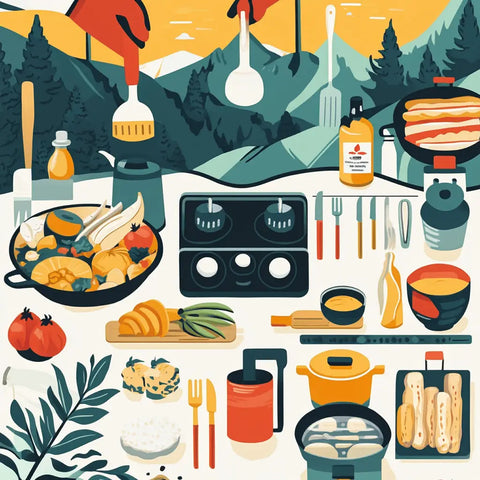
When you’re out in the wilderness, the last thing you want is to worry about what to eat. This is why planning your camping meals is crucial. Good meal planning allows you to save time, reduce waste, and ensure that everyone has something delicious to eat. Additionally, it helps you stay organized and minimizes the chances of forgetting essential ingredients.
Planning ahead also ensures you can cater to dietary needs and preferences, whether they are vegetarian, gluten-free, or simply picky eaters. With a bit of foresight, you can create a satisfying menu that everyone will enjoy.
Planning Your Camping Food
When preparing for a camping trip, thoughtful meal planning is essential to ensure everyone enjoys their outdoor experience. By considering dietary preferences, trip duration, and available resources, you can create a well-rounded menu that satisfies all campers.
1. Assessing Dietary Needs and Preferences
The first step in planning your camping food is to consider the dietary needs and preferences of everyone in your group. This could include allergies, dislikes, or dietary restrictions. Make a list of what everyone enjoys eating to help you create a diverse menu.
2. Duration and Location Considerations
The length of your camping trip and the location can also influence your meal planning. For shorter trips, you may want to focus on easy, no-cook meals, while longer excursions might allow for more elaborate cooking.
Additionally, consider the availability of fresh food and cooking facilities at your campsite. If you’re heading to a remote area, it may be best to rely on non-perishable items.
3. Creating a Camping Meal Plan
Once you've assessed everyone's needs and considered the duration and location, you can start creating your camping meal plan. Outline meals for each day of your trip, including breakfast, lunch, dinner, and snacks. Aim for a variety of meals that balance nutrition and taste.
Essential Camping Food Items
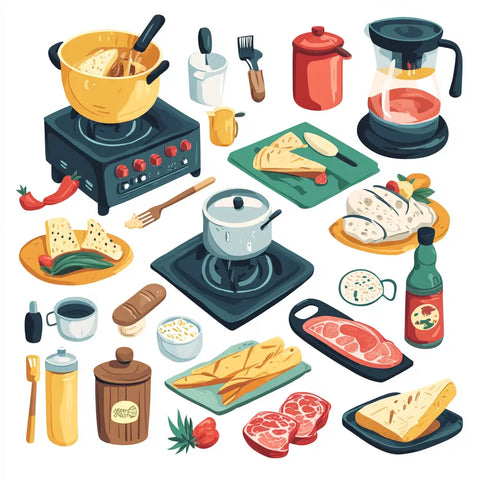
Having the right staples on hand is key to successful camping meals. Below is a list of essential items to consider packing for your trip.
Staples to Pack
- Grains: Rice, pasta, and quinoa are versatile and can be used in various meals. They are easy to prepare and can provide a solid base for many dishes.
- Proteins: Canned beans, meats, tofu, and other protein sources are essential. They not only fill you up but also provide necessary nutrients for energy.
- Vegetables: Fresh vegetables are great for quick meals, while canned or dehydrated vegetables can save space and last longer.
- Snacks: Don’t forget snacks like trail mix, granola bars, and jerky for energy boosts throughout the day.
Best Camping Foods
While the staples are essential, there are some standout camping foods that can elevate your outdoor culinary experience. Consider packing:
- Halloumi: This cheese is great for grilling and adds a unique flavor to your meals.
- Chorizo: This spicy sausage can add a lot of flavor and can be cooked easily over the fire.
- Sardines: Packed with protein and omega-3 fatty acids, sardines are an excellent option for quick meals or snacks.
- Eggs: Easy to cook and incredibly versatile, eggs can be used in breakfast dishes, lunches, and even dinners.
Top Camping Meals for Every Occasion
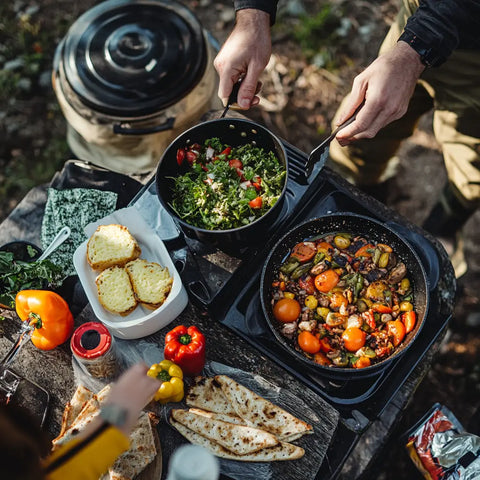
Planning a variety of meals can keep your camping trip exciting and enjoyable. Below are some ideas for breakfast, lunch, and dinner.
1. Breakfast Ideas
- Breakfast Burritos: Fill tortillas with scrambled eggs, cheese, and any desired toppings like salsa or avocado.
- Mountain Breakfast Skillet: Sauté potatoes, bell peppers, onions, and your choice of protein in a skillet for a hearty breakfast.
- Egg Muffins: Whisk eggs with your favorite ingredients, pour them into muffin tins, and bake for a convenient breakfast option.
2. Lunch Options
- Sandwiches and Wraps: Simple to prepare, sandwiches can be made with various ingredients. Consider using whole grain bread or tortillas for added nutrition.
- Pasta Salad: Prepare a pasta salad with vegetables, olives, and dressing for a refreshing and filling meal.
- Quesadillas: Fill tortillas with cheese and other fillings, cook them on a skillet or grill, and enjoy with salsa or guacamole.
3. Dinner Recipes
- One-Pot Meals: Dishes like chili or spaghetti can be made in a single pot, making cleanup easier.
- Grilled Options: Kabobs and skewers are perfect for grilling over the campfire. Just thread your favorite meats and veggies onto skewers and grill to perfection.
- Dutch Oven Recipes: Dishes like beans and rice or stews can be cooked in a Dutch oven over coals, providing warm, hearty meals.
Snacks and Desserts for the Trail
Snacks provide essential energy while hiking or relaxing at the campsite. Here are some easy-to-pack ideas:
Easy-to-Pack Snacks
Nuts, dried fruits, and granola bars are ideal for on-the-go snacking. Nuts like almonds and cashews offer healthy fats and protein, while dried fruits provide natural sweetness and vitamins.
Granola bars are convenient; choose those with whole grains and low sugar. Beef jerky is a satisfying, protein-rich option, and rice cakes or crackers can be topped with nut butter for added flavor. Homemade energy bites made from oats and nut butter are also great for a quick boost.
Sweet Treats
- S'mores are a classic camping favorite, but you can enhance them with peanut butter cups or flavored chocolate.
- Banana boats are another fun treat slice a banana, stuff it with chocolate and marshmallows, wrap it in foil, and heat it over the fire.
- Campfire cones filled with mini marshmallows and fruit are easy to prepare.
- Trail mix cookies can be baked ahead of time for a delightful snack, while chocolate-covered pretzels offer a sweet-and-salty option.
- Fruit skewers made with pineapple and strawberries provide refreshing bites that can be grilled or enjoyed fresh.
These snacks and desserts will keep everyone satisfied during your outdoor adventures!
Best Camping Recipes to Try
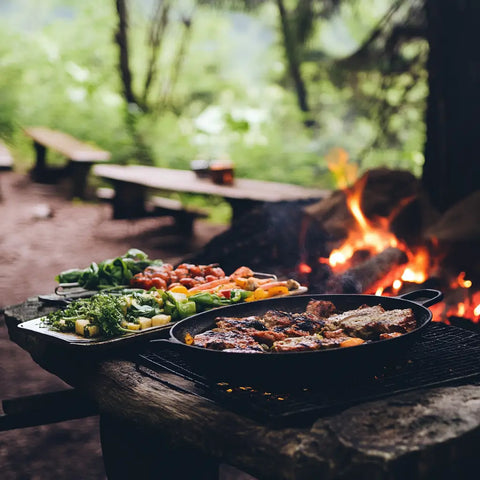
When it comes to camping, having delicious and easy-to-make meals can enhance your outdoor experience. The right recipes can be both satisfying and simple, allowing you to enjoy nature without spending all your time cooking. Here are a few popular camping recipes to get you started on your culinary adventure in the great outdoors:
1. Campfire Nachos
Campfire nachos are a fun and easy dish to prepare at the campsite. Start by layering tortilla chips in a cast-iron skillet, then add generous amounts of cheese, beans, and jalapeños.
Cover the skillet with foil and place it over the campfire or on hot coals; the heat will melt the cheese and warm the ingredients, creating a delicious, gooey snack that’s perfect for sharing around the fire.
2. Chili
Chili is a classic one-pot meal that’s hearty and simple to make, making it ideal for camping. Begin by browning ground beef or your choice of protein in a Dutch oven over the fire.
Then, mix in canned beans, diced tomatoes, and your favorite spices; let it simmer for at least an hour to develop rich flavors. This dish is not only filling but also easy to customize with toppings like cheese, sour cream, and cornbread on the side.
4. Vegetable Stir-Fry
A vegetable stir-fry is a quick and healthy option that allows you to use whatever fresh vegetables you have on hand. Sauté chopped vegetables like bell peppers, zucchini, and carrots in a pan over your camp stove or fire.
Serve them over rice or noodles for a satisfying meal; this dish is versatile and can be adapted based on what’s available or personal preferences, making it a great choice for any camping trip.
These recipes are not only delicious but also easy to prepare, ensuring that your camping meals are enjoyable and stress-free!
Camping Food Prep Techniques
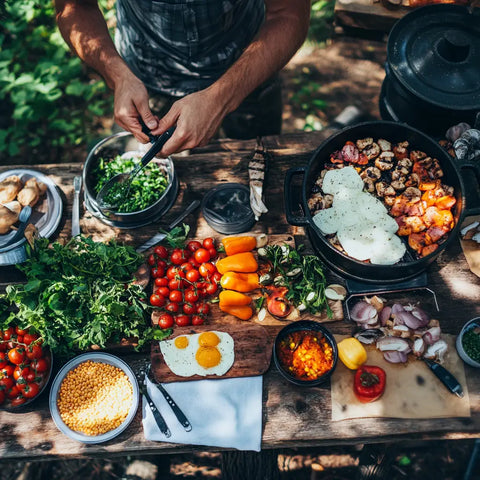
Proper food preparation is vital for a successful camping trip. By employing effective techniques, you can ensure that your meals are not only delicious but also easy to prepare in the great outdoors.
Make-Ahead Meals
Preparing meals at home before your trip can save you time and effort. Consider cooking and freezing meals that can be easily reheated at the campsite.
Dishes like chili, pasta, or casseroles can be portioned into containers and frozen, allowing them to thaw throughout the day in your cooler. This approach minimizes cooking time at the campsite and reduces the need for extensive meal prep.
Storage Tips
1. Using Airtight Containers and Bags
Store food in airtight containers or resealable bags to keep it fresh and prevent spoilage. This is especially important for snacks, pre-cut vegetables, and marinated proteins. Using small containers for condiments can also save space and prevent leaks.
2. Keeping Food Cool in Coolers
If you're bringing perishable items, pack a cooler with ice packs to keep everything chilled. Freeze water bottles to use as ice packs; as they melt, you can drink the water. Be mindful of how long items will stay fresh; consume perishable foods within the first few days of your trip.
Cooking Methods While Camping
Cooking outdoors requires some adjustments compared to cooking at home. The environment, available tools, and cooking techniques can all differ significantly. To make the most of your camping culinary experience, here are some effective methods to consider:

1. Cooking Over a Campfire vs. Portable Stove
Cooking over a campfire is a quintessential part of the camping experience, allowing you to enjoy the ambiance and warmth of an open flame. You can grill meats, roast marshmallows, or even cook stews in cast-iron pots. However, campfires can be unpredictable; controlling the heat can be challenging, and cooking times may vary.
On the other hand, a portable stove offers more precise temperature control. It allows for consistent cooking and is particularly useful for boiling water or sautéing vegetables. Stoves are often easier to set up and can be used in various weather conditions.
When choosing between these methods, consider your preferences for flavor and atmosphere versus convenience and control.
2. Using Dutch Ovens and Foil Packets
Dutch ovens are incredibly versatile and can be used for a variety of cooking methods, including baking, simmering, and roasting. These heavy-duty pots retain heat well and can be placed directly over coals or hung over a fire. You can prepare hearty meals like chili or casseroles, making them perfect for group camping trips.
Foil packets are another excellent option for cooking individual portions of food with minimal cleanup. Simply combine proteins, vegetables, and seasonings in aluminum foil, seal it tightly, and place it on hot coals or grill grates.
This method allows for easy meal customization, everyone can create their own packet with their favorite ingredients while also reducing the number of dishes to wash afterward.
Safety Tips for Outdoor Cooking
- Maintain Distance: Keep a safe distance from the fire to prevent burns or accidents. Ensure children and pets are kept away from cooking areas.
- Monitor Cooking: Stay attentive while cooking to avoid flare-ups, overcooking, or accidents. Never leave a fire unattended.
- Have Emergency Supplies: Keep a fire extinguisher or a bucket of water nearby in case of emergencies. Familiarize yourself with how to use them.
- Know Local Regulations: Check local fire regulations and guidelines before starting your campfire, especially during dry conditions when restrictions may be in place.
- Practice Food Safety:
- Keep raw meats separate from other foods to prevent cross-contamination.
- Use separate utensils for raw and cooked foods.
- Ensure all food is cooked thoroughly to avoid foodborne illnesses.
By following these safety tips, you can enjoy a worry-free cooking experience while camping.
Conclusion
Proper planning, preparation, and cooking can significantly enhance your camping experience. By considering dietary needs, packing essential food items, and utilizing various cooking methods, you can enjoy delicious meals in the great outdoors.
So, embrace the adventure, experiment with different recipes, and savor every moment spent cooking and dining under the stars. Whether you're enjoying simple sandwiches or elaborate one-pot meals, the key is to have fun and make the most of your time in nature.
Also, if you want to purchase all your camping food equipment in one go, make sure to visit Campsupreme.com for all the best items and varieties. So, are you ready for your journey?
Key Points
- Proper planning enhances the camping experience, saves time, reduces waste, and caters to dietary needs.
- Consider allergies, preferences, and restrictions of all campers when creating a diverse meal menu.
- The length of the trip and campsite facilities dictate meal complexity; shorter trips may favor no-cook meals, while longer ones allow for more cooking.
- Pack versatile staples like grains (rice, pasta), proteins (canned beans, meats), fresh or canned vegetables, and snacks (trail mix, granola bars).
- Breakfast Ideas: Quick options include breakfast burritos, mountain breakfast skillets, and egg muffins for hearty starts.
- Lunch and Dinner Options: Sandwiches, pasta salads, quesadillas, one-pot meals, grilled dishes, and Dutch oven recipes provide variety and convenience.
- Easy Snacks and Desserts: Pack nutritious snacks like nuts and granola bars, and consider treats like s'mores, banana boats, and campfire cones for dessert.
- Use campfires or portable stoves, with Dutch ovens and foil packets for versatility and minimal cleanup.
- Ensure proper food storage, monitor cooking closely, keep raw and cooked foods separate, and adhere to local cooking regulations for safety.
- Preparing meals at home and freezing them can save time and effort at the campsite, minimizing cooking hassle.
FAQs
1. What cooking equipment do I need for camping?
Basic cooking equipment includes a portable stove or campfire grill, pots and pans, utensils, and a cooler for perishables.
2. How do I plan meals for a large group when camping?
Consider group preferences and dietary restrictions, then create a shared meal plan with easy-to-prepare recipes that can feed everyone.
3. Are there any foods I should avoid bringing camping?
Avoid bringing foods that spoil easily without refrigeration, such as dairy products, fresh meats, or items that require complicated cooking.
4. How can I make cooking outdoors easier?
Prep ingredients at home, organize your cooking space, and use simple recipes that require minimal equipment for a smoother cooking experience.
5. What are some creative ideas for campfire cooking?
Consider foil packet meals, skewered kabobs, or cooking pizzas using a cast-iron skillet over the fire for creative options.
